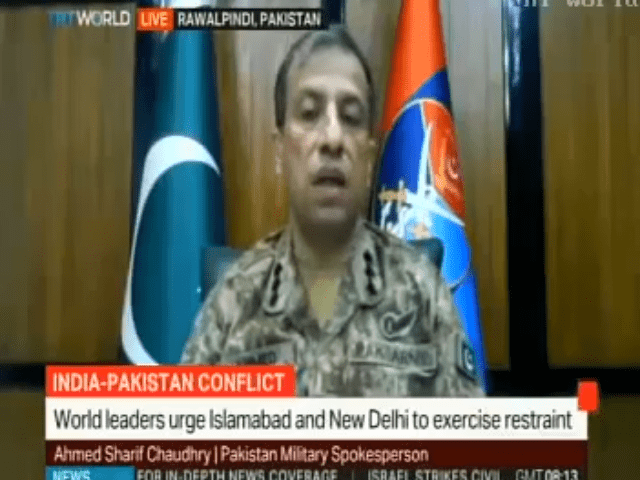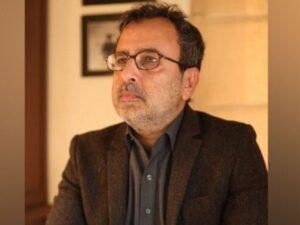Pakistan soldiers rejected India’s claims on crushing drone and missile strikes, declaring that he had only responded with slight weapon shots to Indian artillery bombing along the control line (LOC) and only against military targets.
In an interview with the Turkiye public broadcaster, Turkish Radio and Television World (TRT World), the Director General of Inter-Services Public Relations (DG ISPR), General Ahmed Sharif Chaudhry, said that India’s statements from Pakistani missiles and drones on three Indian military bases were “manufactured” and not supported by proofs.
“Pakistan has not fired rockets, drones or missiles in Indian territory,” said General Chaudhry. “What we do is answer with light weapons in the Indian military posts targeting civilians through the loc.”
He added: “India has created a media blitz, a frenzy and affirming planes, drones and missiles through the international border. This is absolutely false. There is no electronic signature, no pilots captured and no proof – only the narration of the media.”
The CEO ISPR reiterated that Pakistan engages in Indian military positions as a defensive response to the Indian bombing which, according to him, deliberately targeted civilian populations.
“These are not offensive operations. There has been no use of drones or missiles by Pakistan,” he said.
On Wednesday, India accused Pakistan of having attacked military bases with drones and missiles, an allegation that Pakistan has strongly denied. The CEO ISPR said that in today’s war, such attacks would leave electronic signatures and physical evidence, from which India has presented.
The general also responded to the accusations surrounding the recent attack on tourists in Indian illegality occupied Jammu-et-Cachemire (IIOJK), saying that the authors remain unknown.
“We have not been shown any credible evidence connecting the attack to Pakistan,” he said. “India has moved away from the offer of an independent and neutral survey.”
He also accused India of using incidents such as political pretexts. “India has a scheme for using terrorist incidents to justify the assault for domestic political purposes,” he said.
“After Karzhan’s attack, instead of cooperating, India responded with strikes on six locations in Pakistan, including mosques and civil sites, leading to the death of children, women and the elderly,” he added.
Asked about potential economic repercussions, including reports from the International Monetary Fund (IMF) examining the bailout of Pakistan at $ 7 billion, the delayed CEO, saying that such questions are the field of the Ministry of Economic Affairs and the Ministry of Foreign Affairs.
Latest tensions
The latest climbing of tensions between India and Pakistan follows the attack on April 22 in Pahalgam, in India illegally occupied of Jammu and Kashmir (Iiojk), which resulted in 26 deaths. India immediately accused Pakistan elements of orchestrating the attack, although no evidence has been provided. Islamabad firmly rejected these allegations.
In retaliation, India closed the Wagah lands border on April 23, suspended the Industry Water Treaty and revoked Pakistani visas. Pakistan responded by labeling any disturbance in water flow as an “act of war” and closed the Wagah crossing on the side.
The situation erely intensified on Wednesday, while reports from various cities in Pakistan, including Muzaffarabad, Kotli, Muridke and Bahawalpur, detailed several explosions. Pakistan’s military spokesperson, lieutenant-general Ahmed Sharif Chaudhry, confirmed that Indian air strikes had targeted several locations in Pakistan. In response, Pakistan has launched Swift Air and Ground Operations.
During the first hour of reprisals, Pakistan announced the decline in five Indian fighter planes, including four burst aircraft, which India had recently acquired France to strengthen its air defenses following the failure of Balakot’s operation in 2019.
“Pakistan could have killed 10 Indian fighter planes,” said Lieutenant-General Chaudhry during a press briefing. “But Pakistan has chosen to exercise a restraint.”
Despite the magnitude of the answer, the Indian media remained largely silent on the losses. The Hindu, an eminent Indian newspaper, initially reported that three Indian planes had been slaughtered but then deleted the article, probably under pressure from the Indian government to avoid more embarrassment.
An American commentator on CNN said that the potential loss of Rafale planes would seriously damage India’s claim to air superiority, which it had built around the induction of these advanced French warns. Some experts have hypothesized that the confrontation had served as a test of Chinese and Western military technologies, especially after Pakistan acquired J-10C jets in China in response to the Rafale Fleet of India.
A senior French intelligence official confirmed to CNN that a burst plane had indeed been shot down by Pakistan, marking the first time that this sophisticated French plane had been lost in combat.
In another development, the Pakistan armed forces have confirmed the neutralization of 25 HAROP drones of Israeli manufacturing used by India in a recent cross -border activity.
A statement published Thursday by Inter-Services Public Relations (ISPR) of Pakistan confirmed Thursday that these drones had been slaughtered by using both electronic countermeasures (soft-tight techniques) and conventional weapons (hard killers) after being detected in several areas through Pakistan.
The ISPR has described the incursions of the drone as a “desperate and panicked response” by India, which intervened after Pakistan’s reprisal operations on May 6 and 7, in which five Indian hunting planes were slaughtered and several military posts were struck.
Impected by armed drones of Israeli manufacture, called “blur ammunition”, sent by India to several cities in Pakistan, including Karachi, residents of the metropolitan city flocked in the streets in an extraordinary wave of solidarity with the armed forces.
The number of Indian drones killed by the Pakistani armed forces had reached at least 77, confirmed security sources on Friday.




